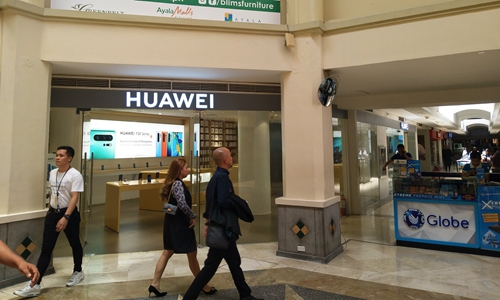SOURCE / INDUSTRIES
Huawei receives a lukewarm welcome in the West, but countries closer to home are eager for cooperation
Countries closer to home are eager for cooperation

A Huawei store stands next to a Globe Telecom booth in Makati City, the Philippines on April 14, 2019. Photo: cnsphoto
While Western countries crack down on Chinese telecoms giant Huawei, countries in Southeast Asia are extending an olive branch and showing interest in cooperating with Chinese 5G enterprises.Southeast Asia, long seen as one of Asia's most economically and geopolitically significant regions, has now become a vital overseas market for Chinese telecoms enterprises due to its fast economic growth and young demographic.
With a shift in China's foreign trade since the outbreak of COVID-19, the region has become the country's largest trading partner, with the trade volume growing 4.2 percent year-on-year to 1.7 trillion yuan ($240 billion) from January to May.
Market awaits exploration
Southeast Asia has seen rapid growth in its 4G networks and construction is drawing to an end in some countries. Even though 5G is novel and has not yet been rolled out in the majority of the region, Chinese telecoms equipment manufacturer ZTE believes there will be huge development space.
The company has accumulated well-rounded experience in Indonesia through its cooperation with conglomerate Sinar Mas Group and by providing equipment to Indonesian telecoms operator Smartfren.
"Sinar Mas Group has shown great interest in the deployment of 5G in industrial manufacturing and we have rich practical experience in 5G-related business scenarios," ZTE told the Global Times, noting that it is deepening cooperation and actively exploring 5G applications in various industries.
The Chinese company also worked together with Thailand's leading mobile operator AIS on wireless network products, fixed-line and core networks. Through the establishment of an innovation lab, the two are holding deep exchanges on cutting-edge 5G technologies.
ZTE has thus far achieved 46 5G commercial contracts, covering China, Europe, the Asia-Pacific region and the Middle East, cooperating with more than 70 telecoms operators across the globe, the company said.
"We hope to work together with countries in Southeast Asia through abundant 5G business practices to push forward 5G business development," ZTE added.
Stronger support
Unlike some major Western countries that are undecided in adopting Huawei's 5G equipment due to pressure from the US, Southeast Asia is showing more friendliness toward Huawei.
Former Malaysian Prime Minister Mahathir Mohamad last May openly supported Huawei and said the Trump administration's ban on the company was "not the way to go."
"Due to its high quality and cheap price, it is reasonable and wise for telecoms operators in Southeast Asia to adopt Huawei's 5G equipment," Xiang Ligang, director-general of the Beijing-based Information Consumption Alliance, told the Global Times on Tuesday.
He noted that the power consumption of Huawei's 5G equipment is one-third less than other, similar equipment.
The telecoms giant boasts the highest number of 5G patents and has in recent years been involved in the promotion of 5G in Southeast Asia.
On June 20, 2019, the Philippines' leading telecoms operator Globe Telecom elected to use Huawei as its core 5G equipment supplier and has since launched the country's first 5G commercial network service.
The cooperation brought the Philippines' network speeds to record highs of 14.97Gbps, which allow the average download data volume to hit 2 GB per second.
Last August, Huawei signed a Memorandum of Understanding on the application of 5G with Thai telecoms operator TrueMove H, and successfully tested the first 5G international video call between the two countries.
According to Ding Yun, president of Huawei's carrier business group, 27 of Huawei's 5G contracts were from Asia by February. That accounts for nearly 30 percent of Huawei's commercial 5G contracts.
Though the only developed country in the region, Singapore has not come to a decision on whether or not to use Huawei's equipment. It is planning to introduce two independent 5G networks as early as next January and aims to cover the country with 5G networks by 2025, according to Singapore's Infocomm Media Development Authority.
"Unlike the UK, Australia and Canada, which have become little brothers of the US on Huawei's ban, countries in Southeast Asia are unlikely to follow the US' reckless crackdown. As close neighbors and good trade partners, they will intend to keep good relations with China," Xiang noted.
According to the latest survey report from the Center for Strategic and International Studies, China is gaining influence in Southeast Asia while the US is falling behind.
Economically, "the region views China as much more influential than the United States today, and the gap is expected to grow in the next 10 years," the report read.
Smartphone drive
A boom in smartphone sales has greatly boosted the region's telecoms revolution. That means Chinese smartphone makers that have already occupied a significant market share in the region stand to benefit more in the region's 5G development in the future.
Even though Samsung remains the most popular smartphone brand in Southeast Asia, Chinese phone makers such as Oppo, Vivo and Realme occupy a lucrative share of the market.
Realme is dreaming big in Southeast Asia. It is set to sell 5G products in Thailand, Malaysia, Indonesia and Cambodia from the beginning of July, the company told the Global Times.
"The potential of 5G in the Southeast Asian market is huge. According to our survey of users in Southeast Asia, 5G is one of the top five factors for local smartphone buyers. This result allowed us to see users' passion for the new 5G technology, even if it has not been popularized in the market," Realme said in a statement sent to the Global Times on Tuesday.
A GSMA 2018 report noted the Asia-Pacific region will become the world's largest 5G region by 2025. And Asia will have 675 million 5G connections by 2025, more than half of the global total expected by that time.



